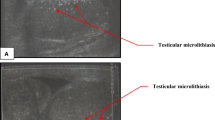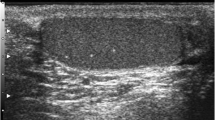Abstract.
The aim of this article is to report on six pediatric cases of testicular microlithiasis (TM) and to review literature reports, in order to schedule US and/or other control examinations, particularly when concomitant focal or diffuse alterations of the testicular parenchymal structure are present, considering the possible association of TM with testicular tumors. Six patients (age range 4–12 years) underwent US examination for scrotal trauma (two cases) unilateral cryptorchidism (one case) follow-up after orchidopexy for bilateral cryptorchidism (one case), and varicocele (two cases). Five examinations were performed with high-frequency probes (10/13 MHz) and seven with 5/7.5-MHz frequency transducers. Follow-up US examinations were performed at different times depending on initial clinical indications, presence of underlying disease, and initial US findings. Two of the six patients underwent three US examinations, two patients underwent two US examinations, and the remaining two patients underwent only one US examination. The patients underwent a total of 12 US examinations. Microliths were bilateral in four patients and unilateral in two patients. In these two latter cases, the contralateral testis was, in one case, cryptorchid and could not be evaluated by US; in the other case it was small and hyperechogenic with orchidopexy sequelae. In three cases microliths were distributed throughout the testis. In the remaining three cases they were present in limited areas of parenchyma. As to the importance of microliths, it was defined as mild in three cases and moderate/severe in three cases. Intratubular testicular microlithiasis is a well-proved histological finding (biopsy or autopsy). More recent is the US demonstration of TM with consequent definition of its pattern: usually bilateral hyperechogenic multiple small foci without acoustic shadows with complete or partial extension to the parenchyma. Testicular microlithiasis is a rare finding. Moreover, the pediatric cases reported in the literature are very few. However, the use of high-frequency US transducers (10–13 MHz) has recently allowed an easier demonstration of this disease also in children. Of particular interest is the study of the still-debated association of microliths with other diseases such as neoplasms. Some aspects need further investigation, namely the real incidence of microliths in the healthy population, the incidence of tumors in patients with microliths, the differences between adults and children, and the different types of follow-up at different ages. In pediatric age, if TM represents an isolated sign, patients need non-invasive US follow-up until adult age. Only if TM is in association with focal lesions of testis parenchyma is it mandatory to perform biopsy or surgical treatment.
Similar content being viewed by others
Author information
Authors and Affiliations
Additional information
Received: 17 June 1998; Revision received: 26 August 1998; Accepted: 21 September 1998
Rights and permissions
About this article
Cite this article
Dell'Acqua, A., Tomà, P., Oddone, M. et al. Testicular microlithiasis: US findings in six pediatric cases and literature review. Eur Radiol 9, 940–944 (1999). https://doi.org/10.1007/s003300050772
Issue Date:
DOI: https://doi.org/10.1007/s003300050772




